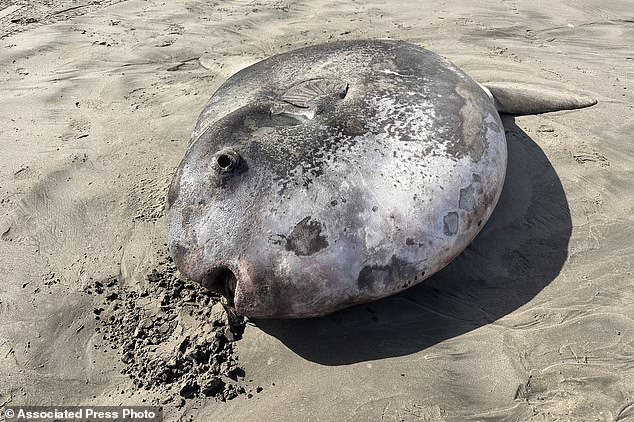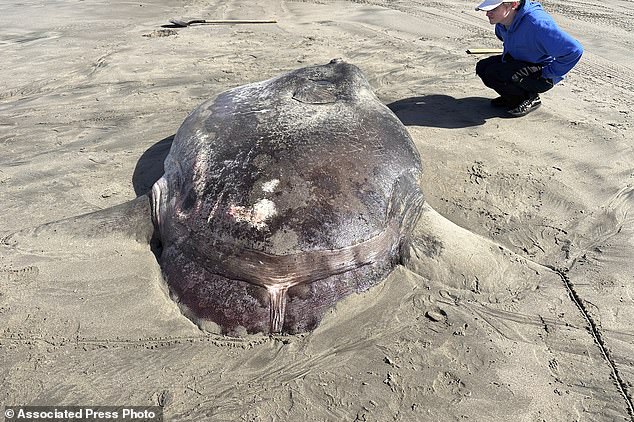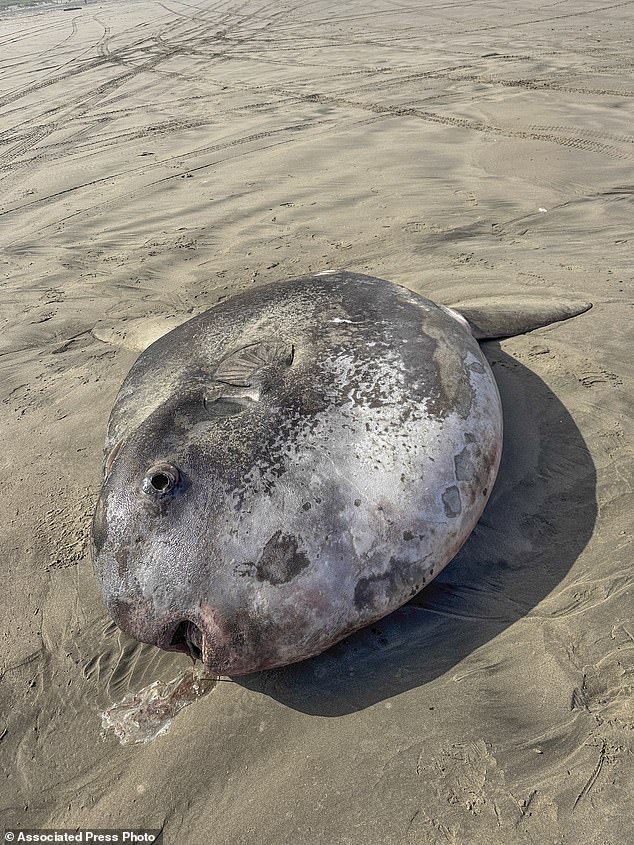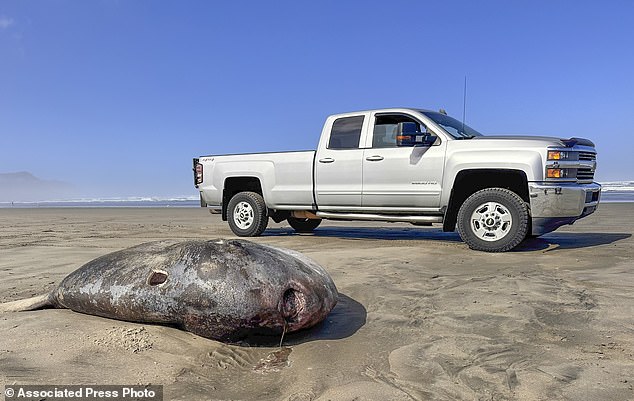A 7.3-foot specimen of a gigantic fish that can grow to more than two tons has turned up in an Oregon coastal town, far north of the warm waters it normally calls home.
Gearhart marine scientists identified the giant fish as a “trickster sunfish,” a new species discovered in 2017 because its appearance is deceptively similar to that of the “ocean sunfish.”
Representatives from Gearhart’s Seaside Aquarium said the stranded trickster “will probably stay a few more days, maybe weeks,” as the tough skin of this sea creature’s carcass tends to make it nearly impervious to scavengers.
“Dubbed a new species hiding in plain sight, it was genetic sampling and final observation that contributed to its discovery,” the aquarium said in a statement.
A 7.3-foot specimen of a gigantic ‘trickster sunfish’, which can grow to more than two tons, has turned up in an Oregon coastal town, far north of the warm waters it normally calls home.

These images, provided by Seaside Aquarium, show the trickster sunfish that washed ashore on June 3, 2024, along Gearhart Beach, Oregon.
The huge, rare fish has attracted crowds of onlookers intrigued by the unusual sight.
“This large, strange looking fish was creating quite a stir on social media and even though it was stormy, people flocked to the beach to see this unusual fish,” said a Seaside Aquarium Representative posted on Facebook.
Photographs taken by aquarium staff documented the flat, round, mottled gray appearance of the trickster as the stranded fish rested on its side in the sand.
Photographs of the large dead fish were also taken next to a person and a van, giving a better idea of the scale of the sunfish’s incredible size.
The social media frenzy over the stranded creature prompted the Danish marine biologist who first discovered the trickster species about seven years ago to reach out in an effort to help confirm what type of sunfish had washed ashore.

Photos taken by aquarium staff documented the flat, round, mottled gray appearance of the trickster as the stranded fish rested on its side in the sand.

Photographs of the large dead fish were also taken next to a person and a van, giving a better idea of the scale of this trickster sunfish’s incredible size.
Dr. Marianne Nyegaard, a New Zealand-based marine biologist, requested “samples for genetics,” according to the aquarium, which provided “further photographs, measurements and tissue samples.”
But only through photographs, Dr. Nyegaard was able to confirm that it was not only a trickster sunfish, but it may be the largest specimen ever sampled.
In research published in 2017, Nyegaard discovered through genetic sampling and observation that the trickster sunfish, or Mola tecta, was a different species than the ocean sunfish, Mola mola.
‘Tecta’ is Latin for hidden or disguised, referring to a new species that had been hiding in plain sight.

“Sunfish are not particularly rare, but they are tricky to study as they simply live in parts of the ocean that most humans don’t go to,” according to New Zealand-based marine biologist Dr. Marianne Nyegaard, who was the first to discover the trickster species in 2017
speaking to The conversation, Shortly after its discovery in 2017, Dr. Nyegaard confessed that “unraveling this mystery has been a great enigma.”
“Sunfish are huge, largely solitary and quite elusive,” he explained, “so you can’t just go out and try a bunch of them to study them.”
“Sunfish are not particularly rare, but they are difficult to study because they simply live in parts of the ocean that most humans don’t go to,” he said.
“They dive hundreds of meters to feed and then rise to the surface to sunbathe on their side, hence their name.”
In recent years, some rarer cases of trickster sunfish have emerged off the coasts of California and Alaska, both farther from their more tropical or temperate ocean homes than previously thought possible.
“This fish, hiding in plain sight, has probably already been seen (or) washed ashore in the Pacific Northwest,” Gearhart’s Seaside Aquarium said, “but was mistaken for the more common Mola mola.”


